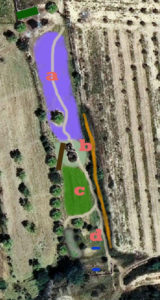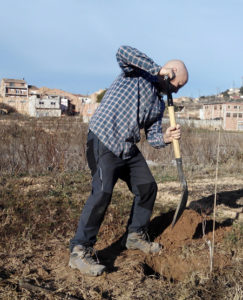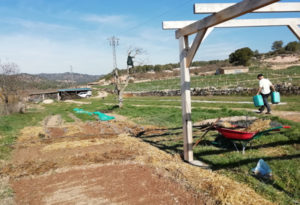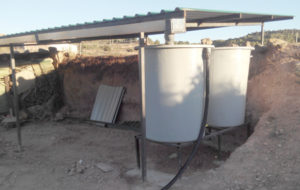Spring 2017, and the good news is that the outdoor clothing company Patagonia have conceded us one of their environmental grants to help us with our “Bovera, from brown to green” project! Our primary aim is to turn an unused field into a small haven for wildlife, whilst growing organic food and promoting nature-related leisure, education and local business.

Zoning the Pou del Mano project: the original idea
a = lavendar and aromatics; b= well, chill-out area; c = vegetables; d = wildlife
One of the core premises of this project is to plant fruit trees aimed at eventually establishing a food forest, a place where fruit trees will flourish, people will enjoy the shade and picking and eating the fruit growing on the trees, birds and other wildlife will occupy and alter the new niches being created, and bushes, flowers and vegetables can be grown in the shade and open areas between the trees.

Planting a tree in Bovera
Bearing in mind that this is a harsh Mediterranean continental climate, with very low rainfall (below 400mm per year) and very high evapo-transpiration (summer maximum temperatures approach 40ºC), and that we wanted to avoid installing an irrigation system, the first task would be to select the appropriate tree species.
In the end we planted 2 or 3 of each of the following: cherry, quince, persimmon, apricot, pomegranate and fig, and half a dozen sea buckthorn. First off, the sea buckthorn were having none of it, immediately went into a sulk, and started dying. The others dragged their heels, but a quick survey 2 years later and only the original quince and the pomegranate survive.
We did our best, but obviously it wasn’t good enough. So what happened? An analysis of likely factors and explanations would be vital if we were to learn from the experience, which was our intention, rather than to give up. So as not to get too long and technical, we’ll focus on just one factor – water.

Up and down the path we go
Water and drought – even if a relatively drought resistant tree needs only 600mm of rainfall in a Mediterranean climate, when you only get between 200 and 300mm rainfall a year it doesn’t mean you can just add the extra 300 mm or so at the base of the tree (300 litres per square metre) and everything is OK. For one thing, what is the real water deficit of a particular tree in a particular area?
In other words,
(i) what is the tree’s surface area “of influence”, ie does it only extract water and nutrients from 2 or 3 square metres around the trunk?
(ii) Does the dry, unirrigated soil around that area use some of the water that you provide through capillary action, soil-dwelling organisms, invasive roots of other species?
(iii) How do you determine the most crucial moments, when the tree needs water the most?
(iv) If the temperature rises above what is “normal”, how will that affect water consumption and availability to the tree?
(v) What effect does your soil’s water retention capacity have on the ideal frequency and quantity of watering?
(vi) And what other factors can’t I think of right now?
All these are often unanswered questions that may flash through your mind as you struggle down the path with two 25-litre drums, wondering how much water to gift your trees with today.
Then when the trees start wilting you hurry to install olles (see previous Pou del Mano post). Hopes are high, they function correctly, and very soon the surrounding weeds have sent out roots to smother and command this new resource (scramble competition) before any more slow-growing competitors (trees) can get there.
But don’t despair! The new, on-site rain roof, equipped with 2,000-litre tanks and 40 m2 of rain-catching surface will spare us from having to use the mains water, even if we do have to continue watering by hand. If only it would rain. And then … it rains in November, when the trees that have survived the summer won’t thank you for your contributions.

The rain roof and water tanks
So then, your pride around your ankles, you turn to irrigation, just like everybody else. The lessons of life and living.
We recommend
Iceland Awakes! An awesome spring tour.
A real client review
“In September 2018, together with my non birding son, I went on a 10 day tour of Iceland led by Steve West of Birding in Spain. Steve worked tirelessly to find the birds and we had a very successful birding trip. He also managed to incorporate all the important ‘tourist sites’ and general wildlife into our trip. A very successful tour on a magical island that catered for everyone. We even got the Northern Lights. This was my third birding trip with Steve, he remains my first choice for guided trips.” – Ian, UK.
Next: Where have all the swallows gone?
Leave a Reply